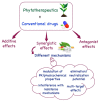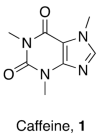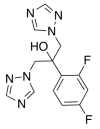Synergistic Effects of Caffeine in Combination with Conventional Drugs: Perspectives of a Drug That Never Ages
- PMID: 37242514
- PMCID: PMC10224171
- DOI: 10.3390/ph16050730
Synergistic Effects of Caffeine in Combination with Conventional Drugs: Perspectives of a Drug That Never Ages
Abstract
Plants have been known since ancient times for their healing properties, being used as preparations against human diseases of different etiologies. More recently, natural products have been studied and characterized, isolating the phytochemicals responsible for their bioactivity. Most certainly, there are currently numerous active compounds extracted from plants and used as drugs, dietary supplements, or sources of bioactive molecules that are useful in modern drug discovery. Furthermore, phytotherapeutics can modulate the clinical effects of co-administered conventional drugs. In the last few decades, the interest has increased even more in studying the positive synergistic effects between plant-derived bioactives and conventional drugs. Indeed, synergism is a process where multiple compounds act together to exert a merged effect that is greater than that of each of them summed together. The synergistic effects between phytotherapeutics and conventional drugs have been described in different therapeutic areas, and many drugs are based on synergistic interactions with plant derivatives. Among them, caffeine has shown positive synergistic effects with different conventional drugs. Indeed, in addition to their multiple pharmacological activities, a growing body of evidence highlights the synergistic effects of caffeine with different conventional drugs in various therapeutic fields. This review aims to provide an overview of the synergistic therapeutic effects of caffeine and conventional drugs, summarizing the progress reported to date.
Keywords: anti-inflammatory drugs; anti-obesity drugs; anticancer drugs; antidiabetic drugs; antimicrobial drugs; caffeine; multidrug therapy; neurodegenerative diseases; opioids; synergism.
Conflict of interest statement
The authors declare no conflict of interest.
Figures










Similar articles
-
Bioactive glasses meet phytotherapeutics: The potential of natural herbal medicines to extend the functionality of bioactive glasses.Biomaterials. 2019 Oct;217:119288. doi: 10.1016/j.biomaterials.2019.119288. Epub 2019 Jun 16. Biomaterials. 2019. PMID: 31252243 Review.
-
Synergistic interactions of phytochemicals with antimicrobial agents: Potential strategy to counteract drug resistance.Chem Biol Interact. 2019 Aug 1;308:294-303. doi: 10.1016/j.cbi.2019.05.050. Epub 2019 May 31. Chem Biol Interact. 2019. PMID: 31158333 Review.
-
Ethnopharmacological uses, phytochemistry, biological activities, and therapeutic applications of Clinacanthus nutans (Burm. f.) Lindau: A comprehensive review.J Ethnopharmacol. 2017 Jul 12;206:245-266. doi: 10.1016/j.jep.2017.05.007. Epub 2017 May 8. J Ethnopharmacol. 2017. PMID: 28495603 Review.
-
More than just caffeine: psychopharmacology of methylxanthine interactions with plant-derived phytochemicals.Prog Neuropsychopharmacol Biol Psychiatry. 2019 Mar 8;89:263-274. doi: 10.1016/j.pnpbp.2018.09.005. Epub 2018 Sep 10. Prog Neuropsychopharmacol Biol Psychiatry. 2019. PMID: 30213684 Review.
-
Phytotherapeutics in cancer invasion and metastasis.Phytother Res. 2018 Aug;32(8):1425-1449. doi: 10.1002/ptr.6087. Epub 2018 Apr 19. Phytother Res. 2018. PMID: 29672977 Review.
Cited by
-
How Does the Powder Mixture of Ibuprofen and Caffeine Attenuate the Solubility of Ibuprofen? Comparative Study for the Xanthine Derivatives to Recognize Their Intermolecular Interactions Using Fourier-Transform Infrared (FTIR) Spectra, Differential Scanning Calorimetry (DSC), and X-ray Powder Diffractometry (XRPD).Mol Pharm. 2024 Sep 2;21(9):4524-4540. doi: 10.1021/acs.molpharmaceut.4c00429. Epub 2024 Aug 7. Mol Pharm. 2024. PMID: 39109552 Free PMC article.
-
Coffee Bean and Its Chemical Constituent Caffeine and Chlorogenic Acid as Promising Chemoprevention Agents: Updated Biological Studies against Cancer Cells.Molecules. 2024 Jul 12;29(14):3302. doi: 10.3390/molecules29143302. Molecules. 2024. PMID: 39064880 Free PMC article. Review.
-
Design, synthesis, analgesic, antibacterial and docking studies of novel 8-piperazinylcaffeine carboxylate ionic liquids.RSC Adv. 2024 Sep 10;14(39):28669-28683. doi: 10.1039/d4ra06244b. eCollection 2024 Sep 4. RSC Adv. 2024. PMID: 39257660 Free PMC article.
-
Anti-Inflammatory and Antioxidant Properties of a New Mixture of Vitamin C, Collagen Peptides, Resveratrol, and Astaxanthin in Tenocytes: Molecular Basis for Future Applications in Tendinopathies.Mediators Inflamm. 2024 Jul 30;2024:5273198. doi: 10.1155/2024/5273198. eCollection 2024. Mediators Inflamm. 2024. PMID: 39108992 Free PMC article.
-
Lacticaseibacillus paracasei LC86 mitigates age-related muscle wasting and cognitive impairment in SAMP8 mice through gut microbiota modulation and the regulation of serum inflammatory factors.Front Nutr. 2024 May 30;11:1390433. doi: 10.3389/fnut.2024.1390433. eCollection 2024. Front Nutr. 2024. PMID: 38873561 Free PMC article.
References
-
- Obodozie-Ofoegbu O. Readings in Advanced Pharmacokinetics—Theory, Methods and Applications. IntechOpen; London, UK: 2012. Pharmacokinetics and Drug Interactions of Herbal Medicines: A Missing Critical Step in the Phytomedicine/Drug Development Process.
-
- Dzobo K. The Role of natural products as sources of therapeutic agents for innovative drug discovery. Compr. Pharmacol. 2022;2:408–422. doi: 10.1016/B978-0-12-820472-6.00041-4. - DOI
Publication types
LinkOut - more resources
Full Text Sources

